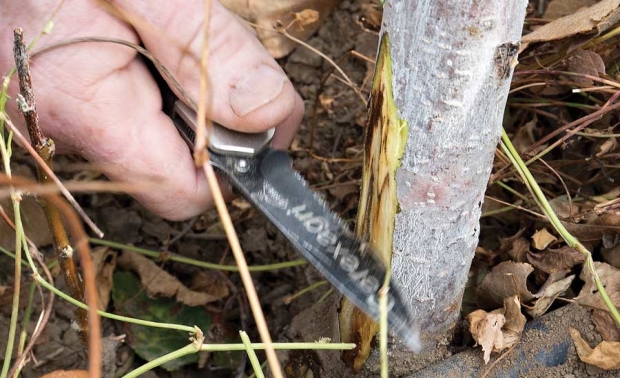
Tim Smith cuts into a young Gala tree exposing fire blight damage during the Washington Tree Fruit Research Commission’s rootstock field day on October 21, 2015 in Wapato, Washington. (TJ Mullinax/Good Fruit Grower)
Researchers continue to examine the best methods to mitigate fire blight damage in an orchard, from pruning and treatment to regular surveys.

Dr. Ken Johnson
Resistance levels to streptomycin in the Pacific Northwest have receded a bit, but there still remains some resistance to the antibiotic in the region, Dr. Ken Johnson, Oregon State University plant pathologist, told growers at the Washington State Tree Fruit Association Annual Meeting in December. Certified organic production no longer allows the use of any antibiotic.
For conventional use, “we think it could be useful on a limited basis, maybe one application per year,” he said. “It was the silver bullet back in the day, but we’re getting closer to where we have silver bullets again by mixing materials.”
Fixed coppers can be used at dormancy to help prevent the disease. Johnson recommended growers implement an integrated control program.
For pears, Johnson said, growers should start with biological controls that target the stigmas, followed by a product mix to improve fire blight control in the floral cup.
One suggestion: Apply a biological agent at early bloom, such as BlightBan (Pseudomonas fluorescens A506), Bloomtime Biological (Pantoea agglomerans E325) and Blossom-Protect (Aureobasidium pullulans), followed by an antibiotic mid-bloom (streptomycin, oxytetracycline or Kasumin).
Kasumin (kasugamycin) is the first antibiotic registered for crop use in 35 years and is in the same family as streptomycin. There is the potential for the bacteria to develop resistance to Kasumin, and Johnson advised against using it in combination with streptomycin.
“You have two resistance risks with strep and Kasumin, and you can do just as well with other mixes,” he said.
For apples, an even better — though more costly — method is to apply lime sulfur during apple thinning, followed by the biological agent, then a combination of Kasumin and oxytetracycline (at 100 parts per million each).
“We did quite a bit of work with mixing Kasumin and found that if we had a full rate of Kasumin and a half rate of oxytet, we just got outstanding control,” Johnson said. “We were really impressed with that.”
Johnson recommended growers producing conventionally grown fruit limit the use of streptomycin to once per season, perhaps after a hailstorm or when the fire blight model is exploding with extreme risk. When used, it should be applied at 100 ppm in combination with a full rate of oxytetracycline (200 ppm).
Johnson also recommended growers consider applying Actigard (acibenzolar-S-methyl), a plant defense inducer that mimics salicyclic acid in the plant.
“It doesn’t give you high levels of control by itself, but it gives you a little better protection for a little longer period,” he said. “An antibiotic may give you a three-day effective residual. With Actigard, you have lingering protection for about four more days.”
Any of the above combinations can be mixed with Actigard at 2 ounces per 100 gallons.
Research studies have shown that oxytetracycline alone provides about 60 percent control of the disease, and one application of streptomycin improves that rate to 80 percent. The addition of two Actigard treatments improves the control obtained from antibiotics another 10 to 12 percent, he said.
“It’s a price-conscious thing. It’s a block-conscious thing. It might be useful in some blocks where you think you might be at very high risk,” Johnson said.
Cleanup
Actigard also is proving to be an effective “paint” during fire blight cleanup in the orchard to help prevent the spread of the disease through the tree, Johnson said. As growers prune and cut away blight, they should paint the cylinder of the tree below the cut for about 12-18 inches or, on a young tree, hit the central leader for about 3 feet.
“Where we paint Actigard, we get a lot less of the fire blight coming back on young trees. It’s not perfect — the blight comes back — but we lose less trees as we clean up,” he said.
Organic producers should check the approved list of materials annually to maintain their certification. •
– by Shannon Dininny






Leave A Comment